文献速递:深度学习–应用深度学习到DaTscan SPECT图像以改善帕金森病运动结果预测
Title
题目
Improved motor outcome prediction in Parkinson’s disease applying deep learning to DaTscan SPECT images
应用深度学习到DaTscan SPECT图像以改善帕金森病运动结果预测
01
文献速递介绍
帕金森病(PD)是一种常见的神经退行性疾病,随着病情的进一步发展,可能导致包括运动迟缓、静止性震颤、僵硬和某些情况下的姿态不稳定等多种症状,从而引发运动功能问题。虽然确切原因尚未明了,但该疾病与黑质中多巴胺能神经元的丧失有关。由于缺乏改变疾病进程的治疗方法,迫切需要找到可靠的疾病进展生物标志物。由于PD症状的异质性及其进展的可变性,预测疾病结果以帮助为适当的患者群体调整临床试验也引起了广泛关注。
多巴胺转运体(DAT)SPECT成像(临床上称为DaTscan)已被广泛用于PD的诊断,它还为早期疾病患者提供了宝贵信息,这些患者具有不确定的帕金森综合症状。能够使用图像以合理的准确性预测患者的结果,将使比较实际与预测结果以确定治疗的长期效能变得更加容易。
DAT SPECT图像的临床应用侧重于视觉检查,而定量分析可能有助于克服早期检测的一些挑战,并改善进展跟踪。基于放射组学的研究在提高诊断、预后、治疗反应评估和进展跟踪的多种临床应用中取得了进展。对于PD,也展示了类似的进展,通过使用DAT SPECT放射组学和其他生物标志物预测认知下降和改善诊断取得了进展。我们之前研究了使用DAT SPECT图像的放射组学特征以及非成像临床特征来预测未来的运动功能,并确定了与预测性能相关的特定成像和临床特征。这些工作展示了从图像的视觉检查转向数据驱动技术的兴趣和可行性。
Methods
方法
2.1. Patient data
*Longitudinal data were extracted from the PPMI database (**www.*ppmi-info.org/data) (Parkinson Progression Marker Initiative, 2011).
The unified Parkinson’s disease rating scale (UPDRS) – part III (motor) score in year 4 was used as the outcome. Predictors included the DAT SPECT images and UPDRS_III score from both the baseline (year 0) andyear
1. These measures were chosen as inputs because our earlier studies showed that they were the most relevant to prediction performance. Other clinical features such as gender, age, MoCA, and disease duration at times of diagnosis and appearance of symptoms were irrelevant . A UPDRS_III score was only considered valid if the patient was not on medication at the time of evaluation. Any patient that had all of the aforementioned data available from the PPMI database was included in this study, resulting in 252 PD subjects (baseline age of 62.4 ± 9.7 be tween 35 and 86; 168 male, 84 female) with year 4 outcome UPDRS_III distribution of 28.7 ± 11.7, ranging between 5 and 77. All images collected in the PPMI database followed a standard acquisition protocol, to account for different SPECT systems used throughout the sites participating in the study. Imaging was done 4 ± 0.5 h after a dosage of 111–185 MBq radiotracer injection. Thyroid protection was provided by pre-treating subjects with an iodine solution before radiotracer injection. The data, in the form of a 128 × 128 matrix, was acquired over a total scan duration of about 30–45 min by sampling every 3◦, 120 projections, 20% symmetric photopeak windows centered on 159 keV and 122 keV. The raw SPECT projection data was recon structed using the iterative OSEM (ordered-subset expectation maximi zation) method on a HERMES system (Hermes Medical Solutions, Stockholm, Sweden). PMOD (PMOD Technologies, Zurich, Switzerland) was then used to apply Chang’s attenuation correction to the recon structed data. PMOD was also used for spatial normalization into Montreal Neurological Institute (MNI) space based on a multisite Eu ropean database of healthy control patients [33]. This resulted in a size of 91 × 109 × 91 voxels for the final images, with voxel size of 2 × 2 × 2 mm3 . As an example, DAT SPECT images of two subjects (a male and a female) taken at years 0 and 1 are shown in Fig. 1. Patient (a) saw his UPDRS_III score progress from 41 to 48 from baseline to year 4 while patient (b)’s score went from 13 to 22 over the same duration. There seem to be image characteristics that could be related to the scores. We expect the method developed in this work to make use of these characteristics.
2.1. 患者数据
从PPMI数据库(www.ppmi-info.org/data)(帕金森病进展标志物倡议,2011)中提取了纵向数据。使用第4年的统一帕金森病评分量表(UPDRS)- 第三部分(III)(运动)得分作为结果。预测因子包括基线(第0年)和第1年的DAT SPECT图像及UPDRS_III得分。选择这些测量作为输入,是因为我们之前的研究表明它们与预测性能最相关。其他临床特征如性别、年龄、MoCA和疾病持续时间在诊断时和症状出现时都被认为是无关的【18, 21】。只有在患者评估时未服药的情况下,UPDRS_III得分才被视为有效。任何从PPMI数据库获得所有上述数据的患者都被纳入本研究,共有252名PD受试者(基线年龄62.4 ± 9.7,范围35至86;168男,84女),第4年结果UPDRS_III分布为28.7 ± 11.7,范围在5到77之间。
PPMI数据库中收集的所有图像都遵循标准采集协议,以考虑研究中参与站点使用的不同SPECT系统。成像在注射111–185 MBq放射性示踪剂后的4 ± 0.5小时进行。通过在注射放射性示踪剂前用碘溶液预处理受试者提供甲状腺保护。数据以128 × 128矩阵的形式获得,通过每3°采样,120个投影,20%对称光峰窗口集中在159 keV和122 keV,总扫描时间约为30-45分钟。原始SPECT投影数据使用迭代的OSEM(有序子集期望最大化)方法在HERMES系统(Hermes Medical Solutions,斯德哥尔摩,瑞典)上重建。然后使用PMOD(PMOD Technologies,苏黎世,瑞士)对重建数据应用Chang的衰减校正。PMOD还用于将空间标准化到基于欧洲多站点健康对照患者数据库的蒙特利尔神经学院(MNI)空间【33】。这导致最终图像的大小为91 × 109 × 91体素,体素大小为2 × 2 × 2 mm³。作为示例,展示了两名受试者(一男一女)在第0年和第1年的DAT SPECT图像,见图1。患者(a)的UPDRS_III得分从基线到第4年从41增加到48,而患者(b)的得分在同一时间内从13增加到22。似乎有些图像特征可能与得分相关。我们期望本工作开发的方法能够利用这些特征。
Results
结果
Using only UPDRS_III scores at year 0 and year 1, the prediction yielded an average difference of 7.6 ± 6.1 between the predicted and actual year 4 motor scores (range ). The average difference was reduced to 6.0 ± 4.8 when longitudinal DAT SPECT images were included, which was determined to be statistically sig nificant via a two-sample t-test, and demonstrates the benefit of including images.
仅使用第0年和第1年的UPDRS_III评分进行预测,预测与实际第4年运动评分之间的平均差异为7.6 ± 6.1(范围)。当纳入纵向DAT SPECT图像后,平均差异减少到6.0 ± 4.8,通过两样本t检验确定这一差异具有统计学意义,证明了包含图像的好处。
Conclusion
结论
This study shows that adding DAT SPECT images to UPDRS_III scores as inputs to deep-learning based prediction significantly improves the outcome. Without requiring segmentation and feature extraction, the CNN based prediction method allows easier and more universial application.
本研究表明,将DAT SPECT图像添加到UPDRS_III评分作为输入到基于深度学习的预测中,显著改善了结果。无需进行分割和特征提取,基于CNN的预测方法允许更容易和更普遍的应用。
Figure
图
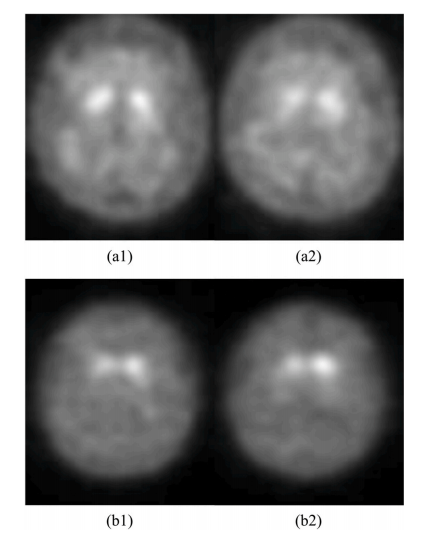
Fig. 1. Example longitudinal DAT SPECT images of two patients (a, b) collected at year 0 (1) and year 1 (2).
图 1. 两名患者(a,b)在第0年(1)和第1年(2)收集的纵向DAT SPECT图像示例。
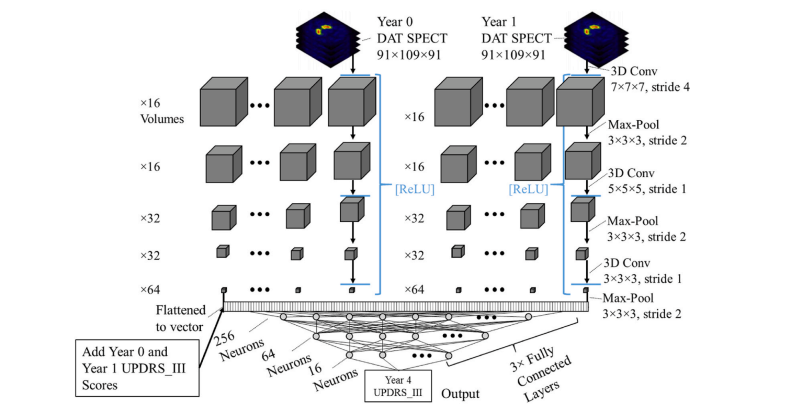
Fig. 2. CNN structure used for prediction of UPDRS_III at year 4, based on longitudinal DAT SPECT images and UPDRS_III scores.
图 2. 基于纵向DAT SPECT图像和UPDRS_III得分,用于预测第4年UPDRS_III的CNN结构。
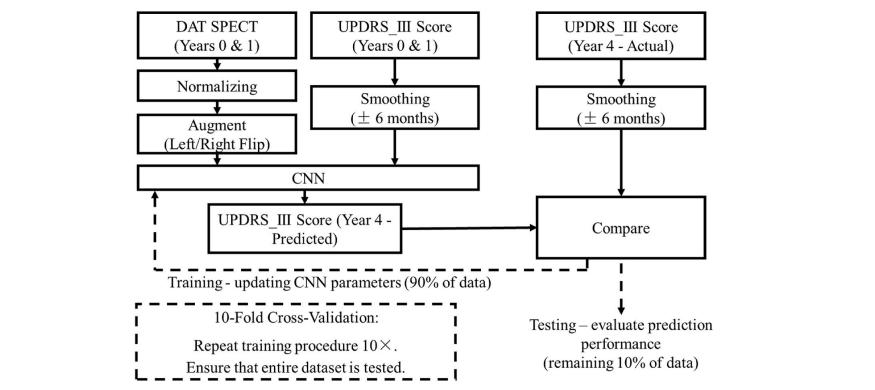
Fig. 3. Training and testing procedure to predict UPDRS_III at year 4 from longitudinal DAT SPECT images and UPDRS_III scores.
图 3. 从纵向DAT SPECT图像和UPDRS_III得分预测第4年UPDRS_III的训练和测试程序。
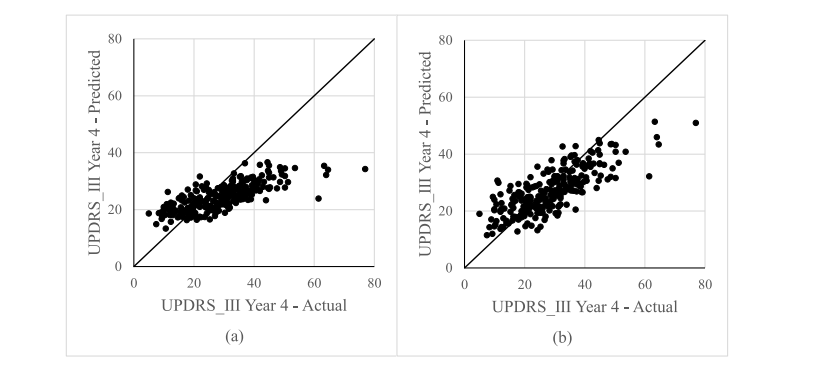
Fig. 4. Predicted versus actual UPDRS_III outcome results at year 4, when using only UPDRS_III scores (a) and when using both UPDRS_III and DAT SPECT images (b). Data from both years 0 and 1 were included.
图 4. 当仅使用UPDRS_III得分(a)和同时使用UPDRS_III得分及DAT SPECT图像(b)时,第4年预测与实际UPDRS_III结果对比。包括了第0年和第1年的数据。
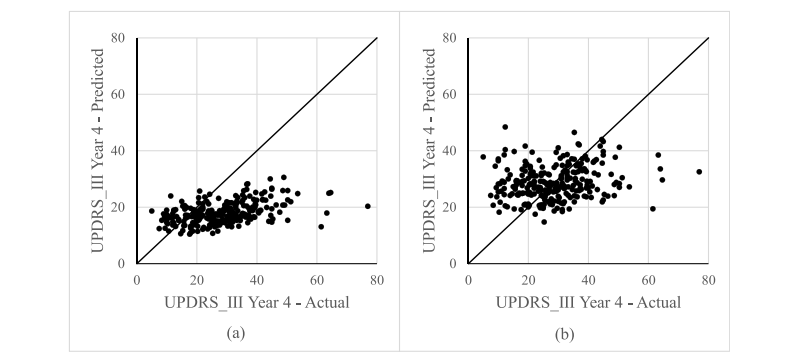
Fig. 5. Predicted versus actual UPDRS_III outcome results at year 4, when using only year 0 UPDRS_III scores as input (a) and when using both UPDRS_III and DAT SPECT images from year 0 as input (b).
图 5. 当仅使用第0年UPDRS_III得分作为输入(a)和同时使用第0年的UPDRS_III得分及DAT SPECT图像作为输入(b)时,第4年预测与实际UPDRS_III结果对比。
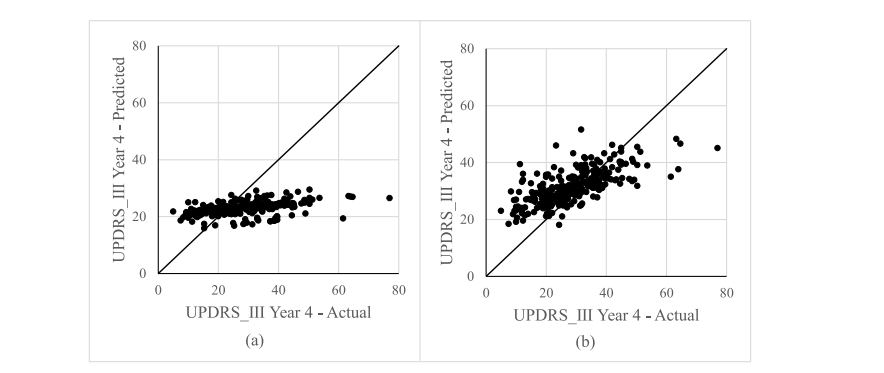
Fig. 6. Predicted versus actual UPDRS_III outcome results at year 4, when using only year 1 UPDRS_III scores as input (a) and when using both UPDRS_III and DATSPECT images from year 1 as input (b).
图 6. 当仅使用第1年UPDRS_III得分作为输入(a)和同时使用第1年的UPDRS_III得分及DAT SPECT图像作为输入(b)时,第4年预测与实际UPDRS_III结果对比。
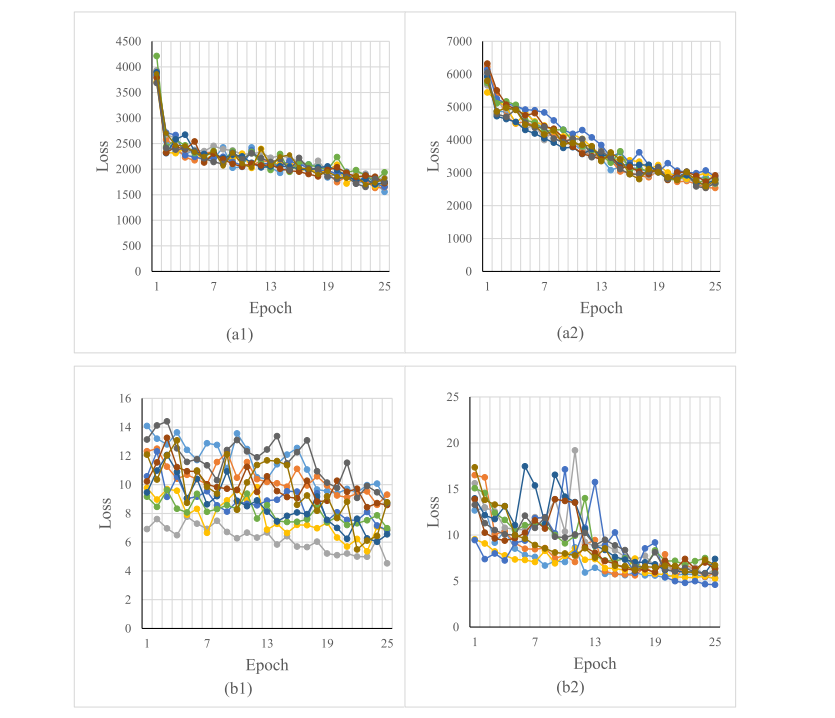
Fig. 7. CNN convergence of training (a) and testing (b) datasets, for prediction cases both without (1) and with (2) DAT SPECT images. Each color signifies a cross validation fold, and loss is measured in mean average error.
both without (1) and with (2) DAT SPECT images. Each color signifies a cross validation fold, and loss is measured in mean average error.*
图 7. 用于预测案例的CNN收敛情况,包括不使用(1)和使用(2)DAT SPECT图像的训练(a)和测试(b)数据集。每种颜色代表一个交叉验证折叠,损失以平均平均误差衡量。
——创建(create)角色脚本(panel)——UserHandler(收)+CreateClick(发)——服务器收包2)

)

)
可视化管理工具(0.5.7 docker版)安装教程)






‘s)






(二))